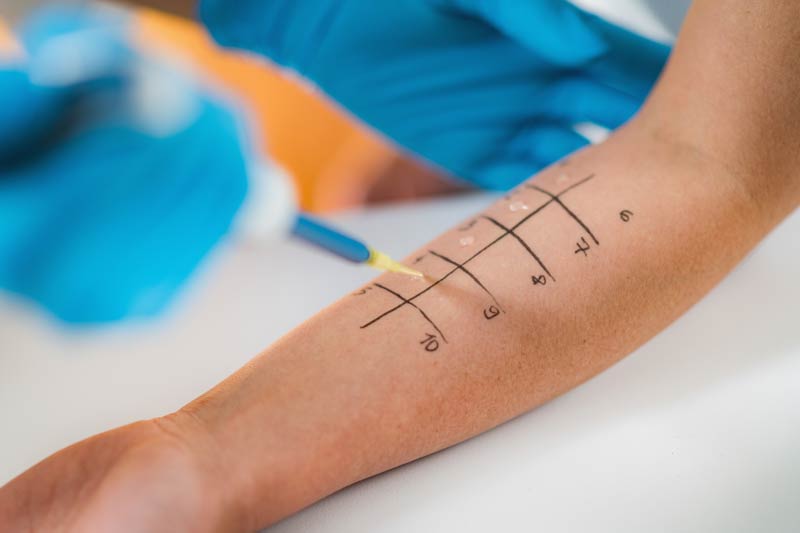Allergy Testing: Types, Process, and What Your Results Mean
Allergies are among the most common chronic conditions worldwide, affecting people of all ages. From seasonal sniffles to life-threatening reactions,...

Allergies are among the most common chronic conditions worldwide, affecting people of all ages. From seasonal sniffles to life-threatening reactions, allergies can significantly impact daily life. Fortunately, allergy testing can identify the substances that trigger your symptoms—giving you the tools you need to manage or avoid allergic reactions.
What Is Allergy Testing?
Allergy testing is a medical process used to determine whether your body reacts to specific allergens—substances that cause allergic reactions. Common allergens include:
- Pollen
- Dust mites
- Mold
- Animal dander
- Insect stings
- Certain foods (e.g., peanuts, shellfish, dairy)
- Medications (e.g., penicillin)
When you’re exposed to an allergen, your immune system may respond inappropriately by releasing chemicals like histamine, leading to symptoms such as sneezing, rashes, itching, or difficulty breathing.
Symptoms That May Indicate the Need for Allergy Testing
If you experience one or more of the following, allergy testing may be beneficial:
- Frequent sneezing or nasal congestion
- Itchy, watery eyes
- Chronic sinus infections
- Unexplained skin rashes or eczema
- Hives or swelling after eating certain foods
- Breathing problems, wheezing, or asthma flare-ups
- Stomach pain or vomiting after meals
- Anaphylaxis (severe allergic reaction)
Types of Allergy Testing
Different tests are used depending on your symptoms, age, and medical history. Below are the most common methods:
1. Skin Prick Test (SPT)
This is the most commonly used test and is performed in a doctor’s office. Here’s how it works:
- Small drops of allergen extracts are placed on your forearm or back.
- A sterile needle is used to lightly prick the skin under each drop.
- After 15–20 minutes, the doctor checks for signs of a reaction (like redness or swelling).
Pros:
- Fast and relatively painless
- Results are available within minutes
- Effective for pollen, dust, mold, pet dander, and some foods
Cons:
- Not suitable for people with skin conditions like eczema
- Can’t be done while taking antihistamines
2. Intradermal Skin Test
Used when more sensitivity is needed (e.g., for insect venom or medications):
- A small amount of allergen is injected under the skin.
- The reaction is measured and interpreted similarly to the skin prick test.
Pros:
- More accurate for certain allergens
- Useful when skin prick tests are inconclusive
Cons:
- Slightly more discomfort
- Higher risk of a false positive
3. Blood Test (Specific IgE Test or ImmunoCAP)
Also known as a RAST or ImmunoCAP test, this measures the amount of allergy-related antibodies (IgE) in your blood.
Pros:
- Useful when skin tests aren’t possible (e.g., for patients with severe eczema or on antihistamines)
- Only one needle prick needed
Cons:
- Results take a few days
- May be less sensitive than skin tests
- Slightly more expensive
4. Patch Testing
Used to diagnose contact dermatitis caused by substances like nickel, latex, or cosmetics.
- Adhesive patches containing allergens are applied to your skin (usually the back).
- You return after 48–72 hours for evaluation.
Pros:
- Helps detect delayed allergic reactions
- Non-invasive
Cons:
- Requires multiple visits
- May be uncomfortable to wear patches for extended periods
5. Elimination Diet and Oral Food Challenge
Used for suspected food allergies:
- You eliminate the suspected food from your diet for a period.
- Under medical supervision, the food is gradually reintroduced to monitor for reactions.
Pros:
- Highly accurate for food-related allergies
- Customizable for your diet and symptoms
Cons:
- Time-consuming
- Risk of severe allergic reaction if not supervised
What to Expect During the Allergy Testing Process
- Medical History Review:
Your doctor will ask about symptoms, lifestyle, family history, and suspected allergens. - Test Selection:
They will recommend the most suitable test(s) based on your symptoms. - Preparation:
You may need to stop certain medications (like antihistamines) before the test to avoid false results. - Testing and Observation:
Most tests are quick and relatively painless, though some may cause mild discomfort or itching. - Results and Follow-up:
You’ll discuss the results with your healthcare provider and create a management or treatment plan.
Understanding Your Allergy Test Results
Allergy test results will tell you whether your body reacts to specific allergens and how severe that reaction might be. Here’s how to interpret them:
- Positive result: You are allergic to that substance and should avoid it or take preventive measures.
- Negative result: It’s unlikely you’re allergic, though false negatives can occur.
- Borderline result: May require further testing or monitoring.
Your doctor may assign a grade or level to indicate how reactive you are to each allergen.
What Happens After Testing?
Once allergens are identified, you and your doctor will develop a plan that may include:
- Avoidance strategies: Minimize contact with known allergens.
- Medications: Antihistamines, nasal sprays, inhalers, or epinephrine auto-injectors (like EpiPen).
- Immunotherapy: Allergy shots or sublingual tablets to build long-term tolerance.
- Lifestyle adjustments: Home air filters, allergy-proof bedding, dietary changes, or pet management.
Conclusion
Allergy testing is a critical step toward controlling your health and improving your quality of life. By identifying your specific triggers, you can take proactive steps to avoid discomfort, reduce risk, and even prevent serious allergic reactions.



